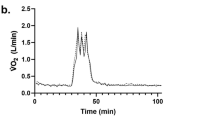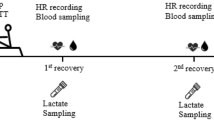Summary
Oxygen consumption (\(\dot V_{O_2 } \)) when rowing was determined on a mechanically braked rowing ergometer (RE) with an electronic measuring device.\(\dot V_{O_2 } \) was measured by an open spirometric system. The pneumotachograph valve was fixed to the sliding seat, thus reducing movement artefacts. A multi-stage test was performed, beginning with a work load of 150 W and increasing by 50 W every 2 minutes up to exhaustion. Serum lactate concentrations were determined in a 30 s break between the work stages. 61 examinations of oarsmen performing at maximum power of 5 W · kg−1 or more were analysed.\(\dot V_{O_2 } \) and heart rate (HR) for each working stage were measured and the regression line of\(\dot V_{O_2 } \) on the work load (P) and an estimation error (sxy) were calculated:\(\dot V_{O_2 } = 12.5 \cdot P + 415.2\) (ml · min−1) (Sxy = ± 337 ml,r = 0.98)
Good reproducibility was found in repeated examinations.
Similar spiroergometry was carried out on a bicycle ergometer (BE) with 10 well trained rowers and 6 trained cyclists.\(\dot V_{O_2 } \) of rowing was about 600 ml · min−1 higher than for bicycling in the submaximal stages for both groups. The\(\dot V_{O_{_2 max} } \) of RE exercise was 2.6% higher than for oarsmen on BE, and the cyclists reached a greater\(\dot V_{O_2 } \) on BE than the oarsmen. No differences were found between RE and BE exercise heart rate. The net work efficiency when rowing was 19% for both groups, experienced and inexperienced: when cycling it was 25% for cyclists and 23% for oarsmen.
Similar content being viewed by others
References
Astrand P-O, Saltin B (1961) Maximal oxygen uptake and heart rate during the first minute of heavy muscular excerice. J Appl Physiol 16:977–981
Bergh U, Kanstrup IL, Ekblom B (1976) Maximal oxygen uptake during exercise with various combinations of leg and arm work. J Appl Physiol 41:191–196
Carey P, Stensland M, Hartley LH (1974) Comparison of oxygen uptake during maximal work on the treadmill and the rowing ergometer. Med Sci Sports 6:101–103
Celentano F, Cortili G, DiPrampero PE, Cerretelli P (1974) Mechanical aspects of rowing. J Appl Physiol 36:642–647
Cerretelli P, DiPrampero PE, Sassi G (1967) The heart rate —\(\dot V_{O_2 } \) relationship in different types of dynamic exercise. Arch di Fisiol II–IV:358–365
Cunningham DA, Goode PB, Critz JB (1975) Cardiorespiratory response to exercise on a rowing and bicycle ergometer. Med Sci Sports 7:37–43
DiPrampero PE (1973) Grundlagen der anaeroben Energiebereitstellung und der O2-Schuld bei körperlichen Höchstbelastungen. Med Sport 8:1–13
DiPrampero PE, Cortili G, Celentano F, Cerretelli P (1971) Physiological aspects of rowing. J Appl Physiol 31:853–857
Fiegenbaum FA, Steinacker JM, Marx TR, Grünert M, Wodick RE (1983) Exercise-specific medical examination of oarsmen and cyclists for the diagnosis of exercise efficiency. Int J Sports Med 4:71
Hagberg JM (1984) Physiological implications of the lactate threshold. Int J Sports Med 5:[Suppl] 106–109
Hagerman FC, Addington WW, Gaensler EA (1972) A selection of selected physiological variables among outstanding competitive sportsmen. J Sports Med 12:12–22
Hagerman FC, McKirnan MD, Pompei JA (1975) Maximal oxygen consumption of conditioned and unconditioned oarsmen. J Sports Med 15:43–48
Hagerman FC, Connors MC, Gault JA, Hagerman GR, Polinski WJ (1978) Energy expenditure during simulated rowing. J Appl Physiol 45:87–93
Jackson RC, Secher NH (1976) The aerobic demands of rowing in two Olympic rowers. Med Sci Sports 8:168–170
Kindermann J, Haralambie G, Kock J, Keul J (1973) SÄure-Basen-Haushalt und Lactatspiegel im arteriellen Blut nach olympischen WettkÄmpfen. Med Welt 24:1176–1178
Liljestrand G, Lindhart J (1920) Zur Physiologie des Ruderns. Skand Arch Physiol 39:215–235
Linnarson D (1974) Dynamics of pulmonary gas exchange and heart rate changes at start and end of exercise. Acta Physiol Scand [Suppl] 415
Mader A, Hollmann W (1977) Zur Bedeutung der StoffwechselleistungsfÄhigkeit des Eliteruderers in Training und Wettkampf. Beiheft zum Leistungssport 9:8–62
Margaria R (1979) Biomechanics and energetics of muscular exercise. Clarendon Press Oxford
Margaria R, Mangili F, Cuttica F, Cerretelli P (1965) The kinetics of the oxygen consumption at the onset of muscular exercise in man. Ergonomics 8:49–54
Marx Th (1985) Untersuchungen zur sportartspezifischen Leistungsdiagnostik mit dem Ruderergometer. Dissertation UniversitÄt Ulm
Mellerowics H, Hansen G (1965) SauerstoffkapazitÄt und andere spiro-ergometrische Maximalwerte der Ruder-Olympiasieger im Vierer m. St. vom Berliner Ruderclub. Sportarzt Sportmed 16:188–191
Mickelson TC, Hagerman FC (1982) Anaerobic thresholds measurements of elite oarsmen. Med Sci Sports Exercise 14:440–444
Nolte V, Mader A, Klauck J (1983) Vergleich biomechanischer Merkmale der Ruderbewegung auf dem Gjessing-Ergometer und im fahrenden Boot. In: Sport: Leistung und Gesundheit (Dtsch. SportÄrztekongre\ 1982), Dtsch. Ärzteverlag, Köln, 513–518
Nowacki P, Krause R, Adam K (1969) Maximal oxygen uptake by the rowing crew winning the Olympic gold medal 1968. Pflügers Arch 3 12:R66-R67
Pearce DH, Milhorn HT (1977) Dynamic and steady-state respiratory responses to bicycle exercise. J Appl Physiol 42:959–967
Pendergast D, Leibowitz R, Wilson D, Cerretelli P (1983) The effect of preceeding anaerobic exercise on aerobic and anaerobic work. Eur J Appl Physiol 52:29–35
Racine P, Higelin JC, Engelhard JC, Mindt W (1975) An instrument for the rapid determination of 1-lactate in biological fluids. Med Instr 9:11–14
Roth W, Hasart E, Wolf W, Pansold B (1983) Untersuchungen zur Dynamik der Energiebereitstellung wÄhrend maximaler Mittelzeitausdauerbelastung. Med Sport 23:107–114
Scharschmidt F, Pieper KS (1984) Die aerobe LeistungsfÄhigkeit junger Rudersportler beiderlei Geschlechts. Med Sport 24:43–48
Schneider E (1980) Leistungsanalyse bei Rudermannschaften. Bad Homburg, Limpert Dtsch. Ärzteverlag, Köln, 1983, 169–173
Secher NH, Vaage O, Jensen K, Jackson RC (1983) Maximum aerobic power in oarsmen. Eur J Appl Physiol 51:155–162
Secher NH (1983) The physiology of rowing. J Sports Sci 1:23–53
Steinacker JM, Marx TR, Thiel U (1983a) The construction of an improved rowing ergometer for sports-specific exercise testing. Int J Sports Med 4:69–70
Steinacker JM, Marx TR, Fiegenbaum FA, Wodick RE (1983b) Die Ruderspiroergometrie als eine Methode der sportartspezifischen Leistungsdiagnostik. Dtsch Z Sportmed 34:333–342
Steinacker JM, Marx TR, Thiel U (1984a) A rowing ergometer test with stepwise increased work loads,in: Current Topics in Sports Medicine. Urban und Schwarzenberg, München Wien Baltimore, 175–187
Steinacker JM, Marx TR, Wodick RE (1984b) The oxygen consumption for rowing. Pflügers Arch 400:[Suppl 1] R 61
Steinacker JM, Marx TR, Marx U, Grünert M, Lormes W, Neumann K, Wodick RE (1984c) Examinations on the physical performance of rowers in rowing spiroergometry with a multi stage test and a two stage test. Int J Sports Med 5:297
StrØmme SB, Ingjer F, Meen HD (1977) Assessment of maximal aerobic power in specifically trained athletes. J Appl Physiol 42:833–837
Whipp BJ, Ward SA (1980) Ventilatory control dynamics during muscular exercise in man. Int J Sports Med 1:146–159
Author information
Authors and Affiliations
Rights and permissions
About this article
Cite this article
Steinacker, J.M., Marx, T.R., Marx, U. et al. Oxygen consumption and metabolic strain in rowing ergometer exercise. Europ. J. Appl. Physiol. 55, 240–247 (1986). https://doi.org/10.1007/BF02343794
Accepted:
Issue Date:
DOI: https://doi.org/10.1007/BF02343794




